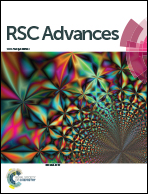Theoretical investigation on donor–acceptor interaction between a carbonyl compound and an N,N′-dioxide–Sc(iii) complex†
Abstract
Herein, metal–ligand bonding features in a chelation N,N′-dioxide–Sc(III) complex have been addressed using the DFT method at the M06/6-31+G** Level. The donor–acceptor interaction between the carbonyl substrate and Sc(III)-based catalyst is analyzed in detail by the activation strain model (ASM), energy decomposition analysis (EDA), and natural orbital for chemical valence (NOCV) calculations. The orbital interaction is the major contributor to N,N′-dioxide–[Sc(OTf)]2+ bonding, whereas the electrostatic interaction plays a more important role than orbital interaction in the activation of a carbonyl compound in hexacoordinate N,N′-dioxide–Sc(III) complexes. The substituents in the amide group of the N,N′-dioxide ligand (L) affect the electrostatic energy as well as the orbital energy between the CH2O and Sc(III)-based catalyst by adjusting the Lewis acidity of the metal centre. The complex with ortho-diisopropylphenyl groups in the ligand exhibits a higher reactivity towards CH2O. Compared to OiPr, the counter ion OTf in the Sc(III)-complex enhances the Lewis acidity of the metal centre and facilitates the activation of CH2O by promoting electron density flow from CH2O to the metal fragment. The high catalytic performance of the N,N′-dioxide–Sc(III) complex towards PhCHO and chalcone is attributed to their good nucleophilicity that results in a more stabilizing electrostatic and orbital interaction between the N,N′-dioxide–[Sc(OTf)]2+ complex and carbonyl substrate.



 Please wait while we load your content...
Please wait while we load your content...